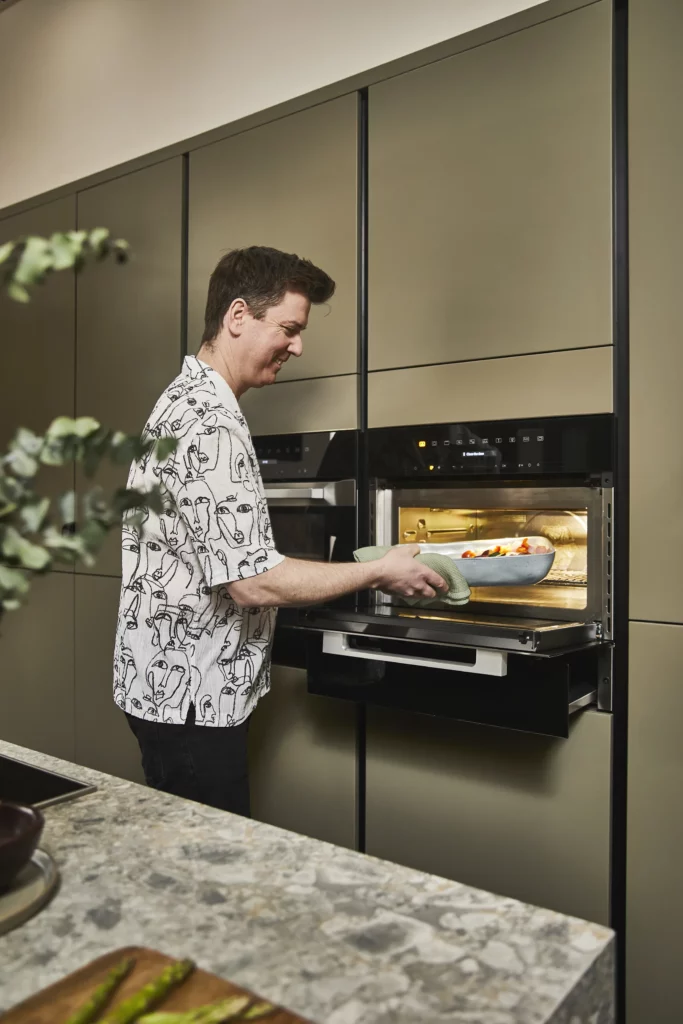How Ally & James utilised sensory design in their Magnet kitchen
Over the past few years, our kitchens have had to become more adaptable than ever before – they’re where many of us cook, work, entertain the kids, help with homework, host friends and so much more.
When D&R co-founders Ally and James Dowsing-Reynolds decided to embark on their kitchen renovation with Magnet, they knew that the design not only had to suit their lifestyle – it also had to work with their sensory needs. Being neurodivergent, Ally and James wanted to create a bespoke space that felt calm while catering to their brains’ unique wiring.

“Elements such as patterns can be very overstimulating for those with neurodiverse minds, yet we still require some form of stimulation, so it’s all about finding the right balance.”
Ally Dowsing-Reynolds
Enlisting help from Magnet’s Head of Design, Jen Nash, Ally and James now have their dream kitchen where they can cook, relax, play games with their daughter, host friends and everything in between.
From choosing storage solutions to planning their layout and lighting, discover the key features of Ally and James’ sensory kitchen design below.
What is sensory interior design?
Interior designer and author of The Sensory Home, Pippa Jameson, describes sensory design as ‘a decorating and styling strategy that ensures all interior spaces activate the human senses – sight, scent, sound, touch, and taste.’ By considering the core five senses when planning and curating a space, you can tailor your design choices to your needs by choosing elements that make you feel relaxed and safe.
Following sensory interior design principles can be particularly beneficial to those living with neurodiversity. Neurodiverse individuals often find that they’re sensitive to certain sounds, scents, and textures that can make them feel overstimulated and uneasy. Creating a space that encapsulates positive sensory experiences can help to make everyday life calmer and more enjoyable.
“You sometimes feel you should choose an ‘Instagram kitchen’ that looks beautiful, but spending months creating and implementing a layout that suits our needs has changed how we interact and work in the space.”
James Dowsing-Reynolds
Rethink the layout
Whether James is cooking up a storm, Ally’s doing crafts with their daughter, or they’re entertaining guests, they wanted their kitchen to become a social space where everyone can easily interact with each other from any corner.
Previously, culinary enthusiast James would face the wall when preparing food due to the layout, meaning he couldn’t fully engage with the rest of the family.
Working with James on the layout, Jen opened their kitchen up by moving the storage to the back wall and adding a central island with a fitted induction hob. Here, James can create delicious meals on one side of the island while chatting with whoever’s seated on the other side.
“The breakfast bar has transformed our family life and how we interact within the space. Having the integrated plug sockets helps us to spend much more time together because we can work, play and chat together easily.”
Ally Dowsing-Reynolds
Try alternative storage solutions
“People with ADHD often want clean environments because it creates a calm feeling within us, but items can easily be forgotten about once stored away,” says Ally.
Taking this into consideration, Jen swapped the traditional deep cupboards you see in many kitchen designs for shallow drawers and a butler’s larder so ingredients and crockery can be neatly stored while also seen at a glance when opened.
Choose calming colours & materials
“Emulating aspects of the natural world – from limestone paints to wooden and ceramic materials – can not only help create a functional kitchen environment but also one that boosts and supports your well-being,” says James.
Incorporating biophilic elements into their kitchen was important to Ally and James, so Jen suggested Magnet’s Soho range in Balmoral (a soft vegetal green) for the cabinets paired with the dark oak of Magnet’s Nordic Nature range and the Dekton in Ceppo work surface to add depth and warmth. These contrasting materials all react to the natural light differently, creating a unique sensory experience throughout the different times of day for just the right amount of stimulation.
Ally finished the look by adding texture with faux plants and foliage to create visual intrigue that promotes tranquillity – something which is key for neurodivergent individuals.

“In the evening, stimulation is brought down a few notches by adjusting the lighting, which helps us unwind after a busy day.”
Ally Dowsing-Reynolds
Create ambience with layered lighting
Using a layered lighting scheme, Ally and James added ambience with a Waldorf pebble lamp to accompany their ceiling spotlights, meaning they can take the space from functional to cosy depending on their mood.
For further control, they added a combination switch that features dimmers and toggles on the same plate. The smoked gold shade tied everything together, with its lived-in finish creating less of a distraction than shiny metallics or a clean white backplate.
Show us your sensory kitchen…
Have you found a kitchen solution that’s transformed your everyday life? Tag @dowsingandreynolds on Instagram – we’d love to take a peek!






